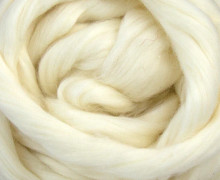 Loading... Please wait...
Loading... Please wait...Categories
New Products
-
$6.50

-
$5.95

-
$60.00

-
$35.95

-
$17.95

Product Description
Cotton is the most widely used fibre in the world, with evidence that it was grown in Egypt as long ago as 12,000 BC. Cotton is also indigenous to North and South America, as well as Asia and Africa.
Originally picked by hand, cotton is now harvested mechanically. Cotton fibres are white, short, uniform and non-lustrous when compared to other plant fibres like bamboo. Sea-Island and Egyptian cotton have the longest staple length, making it easier to hand spin than other cottons.
Cotton accepts dye well.
This product is a “Top” sliver.
Over the years we've found there are regional differences in the use of terms like "sliver", "roving" or "top" and we tend to use the label provided by the supplier (which may not exactly match what a different supplier may label a similar fibre). Often in modern times these terms are used interchangeably, but historically they've had different meanings.
The way we (Birkeland Bros) use the terms, "sliver" would be the 'ropey' gathering of fibre coming off a carding machine.
If a slight twist is introduced to the sliver to give it strength, it is frequently referred to as a "roving" and tends to be finer than a sliver; for example, a “pencil roving” is never more than a pencil-width in thickness. Some mills might also sell one-ply yarns (like Buffalo yarn) as a roving, since without plying that slight twist is what keeps it from pulling apart easily.
If sliver is put through a pin-draft assembly for additional straightening and removal of short fibres, we refer to it as a "Top" sliver. These tend to be more expensive than a regular sliver because of the extra processing, and tends to be less fluffy than a top. Dyed sliver is almost invariably a "top" sliver: why bother dyeing something that isn't a top?!
100g of sliver is typically sufficient to spin enough yarn to knit a pair of socks.
Batts will typically measure 24 inches by 40 inches (61 cm by 102 cm) rolled out, with the thickness varying by weight selected. Batts can be easily separated into layers depending on need. Due to larger dimensions/volume, shipping costs will be higher for batts. Shipping costs for batt quantities greater than 3 lbs (1400g) may be calculated very high but we will always do our best to package efficiently and will refund any postal savings.







